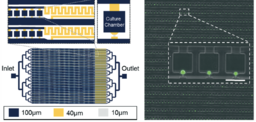Hydro-Seq: High Sample Efficiency Single Cell Whole Transcriptome Analysis Technology
TECHNOLOGY NUMBER: 7243

OVERVIEW
A new microfluidic device for the capture and analysis of single cells- Custom imaging software provides cell number, size, and shape
- Requires little manual labor and increases throughput
BACKGROUND
Attempts to adequately diagnose and treat cancer have let to gene expression studies including evaluation of circulating tumor cells (CTCs) in serum samples. Traditional technologies for studying gene expression have focused on a population average, an approach that masks heterogeneity commonly noted between cancer patients. Furthermore, it is estimated that CTCs make up only 1-5% of the total cells present, which limits identification of their specific characteristics when studied across the whole population. Technologies that assess single cells have drawbacks including being labor intensive and requiring costly reagents. Existing automated technologies may reduce the amount of labor needed to complete single cell analysis, though the resulting stress on those cells can change gene expression or cause cell damage. And, while single cell sorters can use microfluidics to trap and analyze single cells, these technologies leave a large portion of the cells uncaptured. So, a need exists for improved devices to capture and study individual cancer cells.
INNOVATION
Researchers have developed a microfluidic device to help aid in the capture of single cells and can capture over 10,000 cells in one assay. The Hydro-Seq invention allows for efficient capture of single cells (76%) on a small microfluidic chip with even as few as 50 cells loaded. After the cells are gathered, they are lysed and the mRNA is extracted on the chip following which it is bound to barcoded beads for extraction and full transcriptome analysis. The chips are constructed with a range of 800 to 3200 wells per chip, and they can be made with a single chamber which mixes single cells with a single bead or a dual chamber that separates cells and beads. Custom imaging process software analyzes each individual well for quality control and extracts information such as cell number, size, and shape to aid the search for CTSs. The small size of the chip allows for low volume reagent use, making the invention cost effective for research labs as well as a diagnostic tool. The device requires little manual labor and increases throughput. Furthermore, these microfluidic chips can be customized for other assays such as ELISAs, migration assays, and metabolic assays by varying the types of beads used.
PATENT APPLICATION
Number: 16/480,396